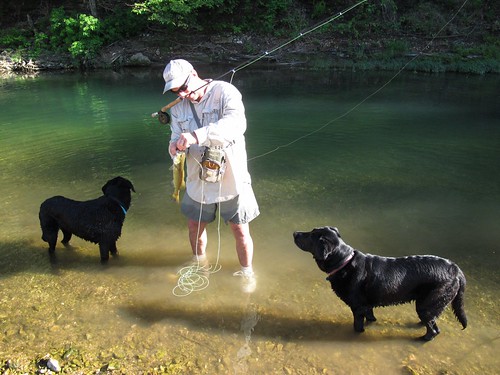A dog is a great companion and partner when it comes to hunting, camping, and many other outdoor activities. Fishing, however, is somewhat of a different story. Whether boat, wade, or shore fishing, it ultimately comes down to personal choice and your dog’s behavior when deciding to take him along. It also depends on whether your dog will be a spectator or a participant. There are a few things to keep in mind when making this decision.
Photo by Flickr user OakleyOriginals
Leash Or Training
The motion when casting is very similar to when you throw a ball or some other object for a dog to fetch. An unleashed dog will likely see this and chase not only your hook into the water, but everyone else’s around you. The last thing you want to do is remove a hook from your dog’s mouth, or worse. The easiest way to take care of this is to leash your dog to a nearby tree. Of course, the dog may bark and whine because he or she is not close to you and the action. Others use a remote dog training collar from PetSafe to correct the behavior as it happens. Your dog can then roam free and learn not to interfere when casting.
Be A Polite Owner
Unless you have a private lake or happen to get very lucky, others will likely fish where you are. They are out there to fish and not deal with the noise and commotion of an ill-mannered dog. Though most dogs like water and the freedom of the outdoors, a fishing trip is not the best time to throw toys in the water for him to fetch. The general consensus from forums and personal experience is that most people do not mind your dog being there as long as it does not interfere with their own experience.
Wade Fishing With Your Dog
Some dogs are actually very good at fishing. If you’re going to allow your dog into the water to potentially catch fish himself, know all the different species of fish that are present. Some can actually harm your dog if they ingest the fish’s blood or outer skin.
Salmon Poisoning Disease can kill your dog if it comes into contact with the Nanophyetus salmincola parasite that itself is infected with a microorganism called Neorickettsia helminthoeca. Dogs are the only species of animal that can catch the disease, according to the Washington State University College of Veterinary Medicine. Salmon and other anadromous fish (those that swim upstream for breeding) are generally only found west of the Cascades, but exercise caution regardless.
Diarrhea, vomiting and/or general weakness days after catching a fish are some of the symptoms a dog will experience if infected. You should seek veterinary help immediately, as the parasite will kill a dog in as little as 14 days.
The last and best advice when taking your dog fishing is to exercise common sense. Everything else will generally take care of itself.

